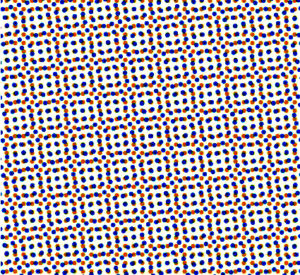
Harmonizing Mesh Count to Line Count
By: Art Dobie
 Harmonizing screen mesh count to halftone line count can limit the possibility for moire and influence achievable tonal range. Moiré is an optical interference pattern that appears when two or more incompatible image frequencies are overlayed on one another. A common source of moire patterns is an improper match between the mesh thread count and the halftone line count. While halftone line counts are fixed values, screen mesh counts change during screen tensioning. The screen tension process introduces elongation into mesh, typically between 4-8%, reaching today’s common operating tension values. For example, a 195-screen mesh when tensioned to 34 n/cm opens up to around 183 threads per inch on the frame (give or take). This factor should be considered when determining the appropriate line count compatibility with your available screens, or when selecting which mesh to use for the line count you’re trying to print.
Harmonizing screen mesh count to halftone line count can limit the possibility for moire and influence achievable tonal range. Moiré is an optical interference pattern that appears when two or more incompatible image frequencies are overlayed on one another. A common source of moire patterns is an improper match between the mesh thread count and the halftone line count. While halftone line counts are fixed values, screen mesh counts change during screen tensioning. The screen tension process introduces elongation into mesh, typically between 4-8%, reaching today’s common operating tension values. For example, a 195-screen mesh when tensioned to 34 n/cm opens up to around 183 threads per inch on the frame (give or take). This factor should be considered when determining the appropriate line count compatibility with your available screens, or when selecting which mesh to use for the line count you’re trying to print.
 A useable Rule of Thumb is to multiply the LPI by a factor of 4.5 (1.8x if metric) to estimate the lowest suitable mesh count. (ex: 45 LPI x 4.5 = 202.5. The closest actual mesh count would be a 195/200 per inch screen.) Keep in mind that a screen’s mesh count combined with the diameter of its threads, in addition to the screen’s stencil thickness, controls the thickness of ink film deposit. Finer mesh types can provide moire-free higher line count halftones, but will also reduce ink laydown thickness, which may affect color and opacity.
A useable Rule of Thumb is to multiply the LPI by a factor of 4.5 (1.8x if metric) to estimate the lowest suitable mesh count. (ex: 45 LPI x 4.5 = 202.5. The closest actual mesh count would be a 195/200 per inch screen.) Keep in mind that a screen’s mesh count combined with the diameter of its threads, in addition to the screen’s stencil thickness, controls the thickness of ink film deposit. Finer mesh types can provide moire-free higher line count halftones, but will also reduce ink laydown thickness, which may affect color and opacity.
Also keep in mind that achievable tonal range is related to both thread diameter as well as mesh opening size and in conjunction with the selected screen type. Generally, the smallest printable dot on any given screen is equal to (2x thread diameter) + (2x mesh opening distance). Therefore, a finer mesh can yield a higher LPI count with a good tonal range, as higher count screen mesh has thinner threads and smaller mesh opening size. This helps explain why some printers elect to print lower LPI halftones with wider tonal range, as the actual dot size in the 95% shadow/5% highlight areas imaged in the screen stencil will still be large enough to reproduce accurately through a matched mesh count.
 Art Dobie is the domestic Technical Sales Representative -Northeast Region for Chromaline Screen Print Products. Dobie has been with Chromaline for 6 years and has an extensive knowledge and hands-on experience within the screen printing industry for over 40 years. If you would like more information about emulsion exposures, you can reach Art at:
Art Dobie is the domestic Technical Sales Representative -Northeast Region for Chromaline Screen Print Products. Dobie has been with Chromaline for 6 years and has an extensive knowledge and hands-on experience within the screen printing industry for over 40 years. If you would like more information about emulsion exposures, you can reach Art at:
Art Dobie
Cell (908) 328-2670
Phone (800) 328-4261 Ext. 250
adobie@chromaline.com
Contact Chromaline Today
If you have any further questions about drying a screen for screen printing, please contact us today.
